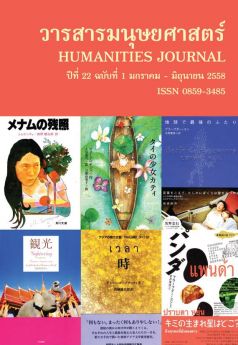การวิเคราะห์ทางเดี่ยวระนาดเอกเพลงพญาโศก ของครูสุพจน์ โตสง่า
Main Article Content
Abstract
การวิจัยเรื่องการวิเคราะห์ทางเดี่ยวระนาดเอกเพลงพญาโศกของครูสุพจน์ โตสง่า กรณีศึกษาสำนักปี่พาทย์ศิษย์สุพจน์ โตสง่า มีวัตถุประสงค์ดังนี้ 1. เพื่อศึกษาบริบทและบทบาทของเพลงเดี่ยวพญาโศก 2. เพื่อวิเคราะห์ทางเดี่ยวระนาดเอกเพลงพญาโศก ของครูสุพจน์ โตสง่า วิธีการดำเนินการศึกษาเป็นการศึกษาเชิงคุณภาพ จากข้อมูลการสัมภาษณ์ เอกสารที่เกี่ยวข้องกับงานวิจัยและการปฏิบัติจริงนำมาสรุปเป็นผลการวิจัย
ผลการวิจัยพบว่าเพลงพญาโศกเป็นเพลงอัตราจังหวะ 2 ชั้น อยู่ในเพลงเรื่องพญาโศกมีเพียงท่อนเดียว ใช้จังหวะหน้าทับปรบไก่ ความหมายของเพลงแสดงถึงอารมณ์เศร้าสลดใจ ในอัตราจังหวะ 3 ชั้น พระประดิษฐไพเราะ (มีแขก หรือ มี ดุริยางกูร) ได้แต่งขยายขึ้นและนำมาประดิษฐ์เป็นทางเดี่ยวในเครื่องมือชนิดต่างๆ
จากโครงสร้างเพลงพญาโศก พบว่าเพลงพญาโศกเป็นเพลงท่อนเดียวมีจังหวะหน้าทับรวมด้วยกันทั้งหมด 8 จังหวะหน้าทับปรบไก่ ซึ่งในการดำเนินทำนองทางเดี่ยวระนาดเอกเพลงพญาโศกของครูสุพจน์ โตสง่า ได้มีการแบ่งทำนองเพลงออกเป็น 4 เที่ยว ดังนี้ เที่ยว 1 ดำเนินทำนองระนาดในรูปแบบของการขยี้ สะเดาะ สะบัด เที่ยว 2 ดำเนินทำนองระนาดในรูปแบบของการรัวคาบลูก คาบดอก เที่ยว 3 ดำเนินระนาดทำนองในรูปแบบของการรัวพื้น เที่ยว 4 ดำเนิน ทำนองระนาดในรูปแบบของการตีเก็บทั้งเที่ยวของประโยคทำนองเพลง
ลักษณะเด่นของทางเดี่ยวระนาดเอกเพลงพญาโศกของครูสุพจน์ โตสง่า ที่ปรากฏอย่างเห็นได้ชัด คือ การบรรเลงรัว 2 เสียง ย้า ลงเสียงคู่ 8 การบรรเลงเหวี่ยงคู่ 3 คู่ 4 และรัวแจกคู่ 8 การบรรเลงรัวสะบัดสำนวนกลอนไต่ลวด การบรรเลง รัวกึ่งสะบัดเสียงคู่ 4 การบรรเลงกลอนย้อนตะเข็บการบรรเลงกลอนแกว่งขึ้นต่อเนื่องด้วยกลอนไต่ลวด ทั้งนี้ผู้ที่จะบรรเลงเพลงเดี่ยวพญาโศกของครูสุพจน์ โตสง่าได้นั้นจะต้องเป็นผู้ที่มีชั้นเชิงและทักษะความเป็นระนาดสูง จึงจะดำเนินทำนองทางเดี่ยวระนาดเอกเพลงพญาโศกของครูสุพจน์ โตสง่าได้เป็นอย่างดี
The Analysis of Tang Diew Ra-nat Ake Pleng Praya-soke of Kru Supot Toe-sangar
Theeraphong Thongperm and Sirichaicharn Fachamroon
This thesis entitled “The Analysis of Tang Diew Ra-nat Ake Pleng Praya-soke of Kru Supot Toe-sangar” aims at first, studying the content and the role of Pleng Diew Praya-soke and secondly, at analyzing Tang Diew Ra-nat Ake Pleng Praya-soke of Kru Supot Toe-sangar. The approach of the study was through compiling data from interviews, documents dealing with research and actual practice.
It was found that Pleng Praya-soke is a songchun Thai song; it was not only one section at that time and used Na Thub Prob Kai rhythm. The meaning of the song conveys sadness. Later on, Pra Pradit Pirhow (Meekaeg, or Mee Duriyangkun) expanded it into a samchun song, and created Tang Diew using several musical instruments.
It was also ascertained that Pleng Praya-soke is a one-section song that has eight Na Thub Prob Kai rhythms. Proceeding the rhythm of Tang Diew Ra-nat Ake of Kru Supot Toe-sangar divides the melody into four times of playing. The first one plays Ra-nat in the style of Ka-yee, Sa-dhow, Sa-bud. The second time is in the style of Kan-rua-kab-luk-kab-dok; another is the style of rua-puen. Lastly, it is the style of tee-khep the whole song. The outstanding characteristics of Tang Diew Ra-nat Ake Pleng Praya-soke of Kru Supot Toe-sangar that differ from others are the playing of twosound rua emphazing sieng khu pad, the playjng of wieng khu sam khu sie and rua jag khu pad, the style of rua sa-bud sam nuan klon tai luad, the playing of half rua half sa-bud sieng khu sie, and the playing of klon yorn ta khept followed with klon tai luad. Those who are able to play Pleng Prayasoke of Kru Supot Toe-sangar well must have expert technique and high skill in playing the ra-nat.


